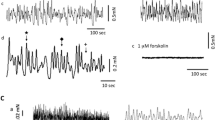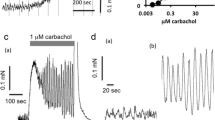Summary
-
1.
The effect of omega-conotoxin (CTX) GVIA, a peptide which blocks neuronal calcium channels, were investigated on nerve-mediated motor responses in a variety of isolated smooth muscle preparations from rats and guinea-pigs.
-
2.
In the rat or guinea-pig isolated vas deferens CTX (1 nM − 1 μM) produced a concentration and time-related inhibition of the response to field stimulation, while the responses to KCI, noradrenaline or adenosine triphosphate were unaffected. In the presence of CTX a series of tetrodotoxin-resistant contractions could be elicited by field stimulation by increasing pulse width and/or voltage.
-
3.
In the rat or guinea-pig isolated urinary bladder, CTX produced a concentration and time-dependent inhibition of twitch responses to field stimulation without affecting the response to exogenous acetylcholine. In the rat bladder the maximal effect did not exceed 25% inhibition while a much larger fraction of the response (about 70%) was inhibited in the guinea-pig bladder. The CTX-resistant response was abolished, in both tissues, by tetrodotoxin.
-
4.
The effects of CTX in the rat bladder were also studied with a whole range of frequencies of field stimulation (0.1–50 Hz). Maximal inhibition was observed toward contractions elicited at frequencies of 2–5 Hz. At low frequencies the inhibitory effects of CTX and atropine were almost additive while at high frequencies of stimulation a large component of the atropine-sensitive response was CTX-resistant.
-
5.
In the rat isolated proximal duodenum, field stimulation in the- presence of atropine and guanethidine produced a primary relaxation followed by a rebound contraction. Both responses were abolished by tetrodotoxin, indicating the activation of intramural nonadrenergic noncholinergic nerves. The primary relaxation was totally CTX resistant while the rebound contraction was slightly inhibited.
-
6.
The motor responses produced by capsaicin (1 μM) in the rat or guinea-pig bladder (contraction) and in the rat proximal duodenum (relaxation) were unaffected by CTX. Likewise, the release of substance P-like immunoreactivity from sensory nerves of the guinea-pig bladder muscle was unaffected by CTX.
-
7.
These findings indicate that CTX-sensitive calcium channels modulate transmitter release in autonomic nerve terminals of mammals, but noticeable species and organ related variations exist in sensitivity to this peptide, possibly reflecting the existence of a heterogenous population of voltage-sensitive calcium channels. CTX-sensitive calcium channels are apparently not involved in the excitatory action of capsaicin on sensory nerve terminals.
Similar content being viewed by others
References
Anderson AJ, Harvey AL (1987) Omega-conotoxin does not block the verapamil-sensitive calcium channels at mouse motor nerve terminals. Neurosci Lett 82:177–180
Augustine GJ, Charlton MP, Smith SJ (1987) Calcium action in synaptic transmitter release. Ann Rev Neurosci 10:633–693
Carpenter FG (1977) Atropine resistance and muscarinic receptors in the rat urinary bladder. Br J Pharmacol 59:48–59
Dooley DJ, Lupp A, Hertting G (1987) Inhibition of central neurotransmitter release by omega-conotoxin GVIA, a peptide modulator of the N-type voltage sensitive calcium channel. Naunyn-Schmiedeberg's Arch Pharmacol 336:467–470
Dun NJ, Kiraly M (1983) Capsaicin causes release of a substance P-like peptide in guinea-pig inferior mesenteric ganglia. J Physiol (Lond) 340:107–120
Fox AP, Nowycky MC, Tsien RW (1987) Kinetic and pharmacological properties distinguishing three types of calcium channels in chick sensory neurones. J Physiol (Lond) 394:149–172
Gamse R, Molnar A, Lembeck F (1979) Substance P release from spinal cord slices by capsaicin. Life Sci 25:629–636
Jancsó G, Karcsú S, Kiraly E, Szebeni A, Toth L, Bacsy E, Joo F, Parducz A (1984) Neurotoxin-induced nerve cell degeneration: possible involvement of calcium. Brain Res 295:211–216
Kerr LM, Yoshikami D (1984) A venom peptide with a novel presynaptic blocking action. Nature 308:282–284
Maggi CA, Meli A (1988) The sensory-efferent function of capsaicin-sensitive neurons. Gen Pharmacol 19:1–43
Maggi CA, Evangelista S, Grimaldi G, Santicioli P, Giolitti A, Meli A (1984) Evidence for the involvement of arachidonic acid metabolites in spontaneous and drug-induced contractions of the rat urinary bladder. J Pharmacol Exp Ther 230:500–514
Maggi CA, Santicioli P, Meli A (1985a) Evidence for the involvement of endogenous substance P in the motor effects of capsaicin in the rat urinary bladder. J Pharm Pharmacol 37:203–204
Maggi CA, Santicioli P, Meli A (1985b) Pharmacological evidence for the existence of two components in the twitch response to field stimulation of detrusor strips from the rat urinary bladder. J Autonom Pharmacol 5:221–230
Maggi CA, Giuliani S, Manzini S, Santicioli P, Meli A (1986a) Motor effect of neurokinins on the rat duodenum: evidence for the involvement of substance P and substance K receptors. J Pharmacol Exp Ther 238:341–351
Maggi CA, Manzini S, Giuliani S, Santicioli P, Meli A (1986b) Extrinsic origin of the capsaicin-sensitive innervation of the rat duodenum: possible involvement of CGRP in the capsaicininduced activation of intramural non-adrenergic non-cholinergic neurons. Naunyn-Schmiedeberg's Arch Pharmacol 334:172–180
Maggi CA, Santicioli P, Meli A (1986c) Postnatal development of micturition reflex in rats. Am J Physiol 250:R926-R931
Maggi CA, Giuliani S, Santicioli P, Abelli L, Geppetti P, Somma V, Renzi D, Meli A (1987a) Species-related variations in the effects of capsaicin or urinary bladder functions: relation to bladder content of substance P-like immunoreactivity. NaunynSchmiedeberg's Arch Pharmacol 336:546–555
Maggi CA, Giuliani S, Santicioli P, Meli A (1987b) Capsaicininduced inhibition of motility of the rat isolated vas deferens: do multiple neuropeptides mediate the visceromotor effects of capsaicin? J Autonom Pharmacol 7:243–255
Maggi CA, Santicioli P, Geppetti P, Furio M, Frilli S, Conte B, Fanciullacci M, Giuliani S, Meli A (1987c) The contribution of capsaicin-sensitive innervation to activation of the spinal vesicovesical reflex in rats: relationship between substance P levels in the urinary bladder and the sensory-efferent function of capsaicin-sensitive sensory neurons. Brain Res 415:1–13
Maggi CA, Santicioli P, Geppetti P, Giuliani S, Patacchini R, Frilli S, Grassi J, Meli A (1987d) Involvement of a peripheral site of action in the early phase of neuropeptide depletion following capsaicin desensitization. Brain Res 436:402–406
Maggi CA, Santicioli P, Geppetti P, Patacchini R, Frilli S, Astolfi M, Fusco B, Meli A (1988a) Simultaneous release of substance P and calcitonin gene-related peptide-like immunoreactivity from isolated muscle of the guinea-pig urinary bladder. Neurosci Lett 87:163–167
Maggi CA, Patacchini R, Santicioli P, Giuliani S, Geppetti P, Meli A (1988b) Protective action of ruthenium red toward capsaicin desensitization of sensory fibers. Neurosci Lett 88:201–205
Marsh SJ, Stansfeld CE, Brown DA, Davey R, McCarthy D (1987) The mechanism of action of capsaicin on sensory C-type neurons and their axons in vitro. Neuroscience 23:275–289
McCleskey EW, Fox AP, Feldman DH, Cruz LJ, Olivera BM, Tsien RW, Yoshikami D (1987) Omega-conotoxin: direct and persistent blockade of specific types of calcium channels, in neurons but not muscle. Proc Natl Acad Sci (USA) 84:4327–4331
Miller RJ (1987) Multiple calcium channels and neuronal function. Science 235:46–52
Nowycky MC, Fox AP, Tsien RW (1985) Three types of neuronal calcium channel with different calcium agonist sensitivity. Nature 316:440–443
Olivera BM, McIntosh JM, Cruz LJ, Luque FA, Gray WR (1984) Purification and sequence of a presynaptic toxin from Conus Geographus venom. Biochemistry 23:5087–5090
Olivera BM, Gray WR, Zeikus R, McIntosh JM, Victoria di Santos JR, Cruz LJ (1985) Peptide neurotoxins from fish-hunting cone snails. Science 230:1338–1343
Rang HP, Bevan SJ, Forbes A, Wood JN (1987) The action of capsaicin on the membrane of sensory neurones, IUPHAR Satellite Symposium, Tools for tachykinin and neuropeptide research. August 29–30, Salamander Bay 1987, Abstract Book
Sano K, Enomoto KJ, Maeno T (1987) Effects of synthetic omega conotoxin, a new type of calcium antagonist, on frog and mouse neuromuscular transmission. Eur J Pharmacol 141:235–241
Santicioli P, Patacchini R, Maggi CA, Meli A (1987) Exposure to calcium free medium protects sensory fibers by capsaicin desensitization. Neurosci Lett 80:167–172
Saria A, Lundberg JM, Hua X, Lembeck F (1983) Capsaicin-induced substance P release and sensory control of vascular permeability in the guinea pig ureter. Neurosci Lett 41:167–172
Spedding M (1987) Three types of calcium channel explain discrepancies. Trends Pharmacol Sci 8:115–117
Szolcsányi J (1984) Capsaicin-sensitive chemoceptive neural system with dual sensory-efferent function. In: Chahl LA, Szolcsányi J, Lembeck F (eds) Antidromic vasodilation and neurogenic inflammation. Akademiai Kiado, Budapest, pp 26–52
Szolcsányi J (1985) Sensory receptors and the antinociceptive effects of capsaicin. In: Hakanson R, Sundler F (eds) Tachykinin antagonists. Elsevier, Amsterdam, pp 45–56
Tapia R, Meza-Ruiz G (1985) Inhibition by ruthenium red of the calcium-dependent release of [3H] GABA in synaptosomal fractions. Brain Res 126:160–165
Author information
Authors and Affiliations
Additional information
Send offprint requests to C. A. Maggi at the above address
Rights and permissions
About this article
Cite this article
Maggi, C.A., Patacchini, R., Santicioli, P. et al. The effect of omega conotoxin GVIA, a peptide modulator of the N-type voltage sensitive calcium channels, on motor responses produced by activation of efferent and sensory nerves in mammalian smooth muscle. Naunyn-Schmiedeberg's Arch Pharmacol 338, 107–113 (1988). https://doi.org/10.1007/BF00174856
Received:
Accepted:
Issue Date:
DOI: https://doi.org/10.1007/BF00174856




